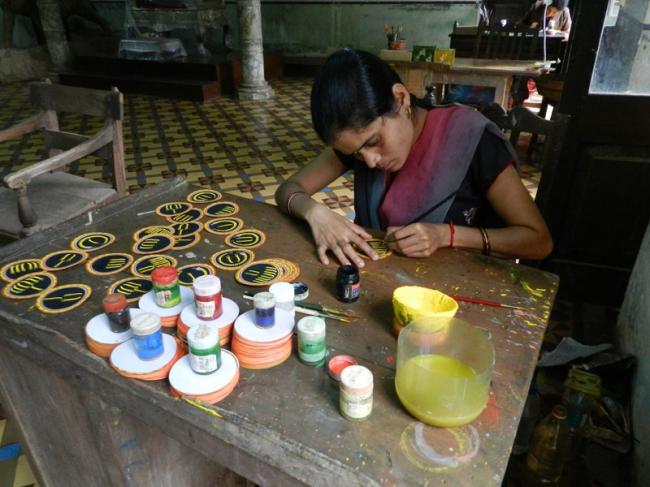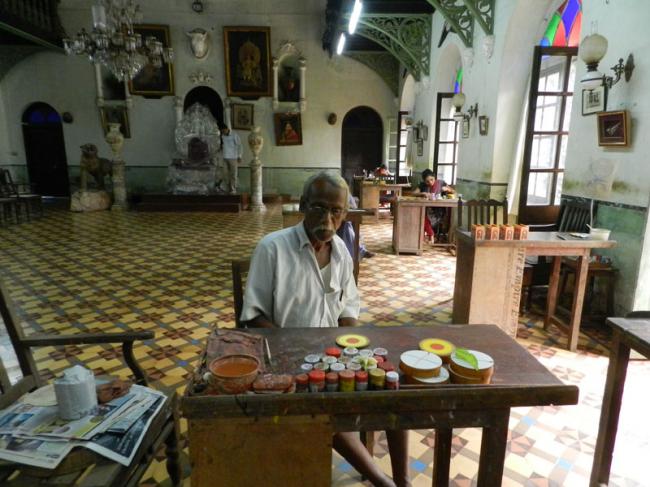
The forgotten games of India
Playing board games is a leisure activity people indulged in for ages. In India, the board game tradition goes back to ancient times but have been lost into oblivion now Uttara Gangopadhyay finds
Sawantwadi in Maharashtra is a quaint little town known for its lacquer toys. Hence it’s a bit of a surprise when one visits the palace to find a training course on the making of Ganjifa cards in progress. Ganjifa is usually associated with Odisha and West Bengal (where it is better known as the Dashavatara cards). But now it seems Sawantwadi shares a common legacy. A little more probing reveals that Ganjifa was also known in Mysore (Karnataka), Gujarat, Rajasthan and Kashmir.
Souvik Mukherjee, assistant professor in Presidency University, Kolkata, points to an antique board game that looks similar to the ‘snakes and ladders’ that children grow up with. Actually, Mukherjee informs, it was the game of ‘gyan chaupar’ once played in India, a precursor to the ‘snakes and ladders’ board game. The Indian version used to picturise stairs instead of ladders.
Irving Finkel, author of Ancient Board Games, surprised the audience at ZEE Jaipur Literature Festival by saying that the game of Pachisi was invented in India but reproduced during the colonial period as the Ludo. According to an article (in the DNA) by Roshni Nair, Irving said, “The English tore the rule book and created an alternative requiring not the slightest response of the soul. They took the good out of that game, repackaging and importing it to India as stupid, anodyne Ludo… Now I see Indians playing Ludo, totally oblivious about the damn good game their forefathers played.”
Tourists to Fatehpur Sikri are shown a large drawing consisting of squares laid out in the design of the Pachisi board on a courtyard as proof that even Emperor Akbar was fond of this game and loved to play it with his courtiers.
India had a rich tradition of board and card games, which are now mostly forgotten, some likely to be lost forever, rue games researchers like Mukherjee.
 That the epic Mahabharata was premised on the game of dice or the mention of Shiva and Parvati playing similar games according to Hindu mythology, are proof that these games were known in India since ancient times. Deme Raja Reddy and Samiksha Deme, in their book titled Ancient Indian Board Games have also shown how carvings in old temples and forts still preserve records of traditional Indian board games. But recollections of these games are fading fast from collective memory, with the result that it is getting increasingly difficult to find people who either know how to play these games or are aware of the rules.
That the epic Mahabharata was premised on the game of dice or the mention of Shiva and Parvati playing similar games according to Hindu mythology, are proof that these games were known in India since ancient times. Deme Raja Reddy and Samiksha Deme, in their book titled Ancient Indian Board Games have also shown how carvings in old temples and forts still preserve records of traditional Indian board games. But recollections of these games are fading fast from collective memory, with the result that it is getting increasingly difficult to find people who either know how to play these games or are aware of the rules.
For example, the rules of playing the Dashavatara cards of Bishnupur in West Bengal are perhaps lost forever. The deck of 120 circular cards contain pictures of the 10 incarnations of Vishnu in the first and second set of 10 cards each (the difference being the incarnations are housed in a temple in the first set while the temple is missing in the second set) and the remaining are marked by dots for numbers.
Studies have revealed that the representation of the incarnations also vary. There is also a smaller pack, called Naqsh (Naksha Taash), which consists of 48 playing cards, divided into 12 sets of four cards each.
Interestingly, in both Odisha and West Bengal, the cards are usually made by ‘Patachitra’ artists. It is difficult to find if there was any relation with the Sawantwadi Ganjifa cards with that of Odisha or if it evolved independently. Was it revived as an art form or was still being used for playing the card game? The only information available is that Satwashila Devi Bhonsle, the erstwhile queen, was keen to ensure its survival.
Pointing to the ‘Gyan Chaupar’ board, Mukherjee explains that it was a game that imparted a lesson in morality too. The life’s journey is full of virtues (ladders) and vices (snakes) and it is for you to find out how best you can ace it. However, it was a popular game across India, and thus variously named – Gyan Bazi, Moksha Patam, Vaikunthapali, Parampada Sopanum, etc. “Exported into England first in 1892, this complex and intricate game of moral teaching ended up as a simple racing-game that removed the element of learning and introduced competition instead.”
In Bengal, it was known as ‘Golok Dham’, a game that was popular even with followers of Sri Ramkrishna Paramhansa. From the accounts of Shudha Mazumdar (Memoirs of an Indian Woman), it is evident that the game was a favourite with women in the early 20th century. She writes, “And we played golok dham, a game in which you went to heaven on a paper board, if you played your cowries right, or else, straight to hell, or a tavern, if you failed. The game held great allure for me and I was forever jingling the little seashells, cowries, which were the dice, and dying to test my luck in our spare time.”
Scholars like Andrew Topsfield, Jen Schlieter and Jakob Schmidt Madsen have written about the Jain, Buddhist and Vaishnav versions of Gyan Chaupar and about boards that have been found all the way from Gujarat to Tibet, says Mukherjee.
Another game that was popular across India was the ‘tiger and goat’ game. Known variously as ‘Bagh-Bandi’, ‘Bagh-Bakri’, ‘Puli Judham’, it was played with symbolic representations of two tigers and 21 goats, where the tigers try to kill the goats and the goats try to surround the tiger (because a tiger cannot kill more than one goat at a time). According to Deme Raja Reddy and Samiksha Deme, at the 12th century built Sri Govindarajaswamy Temple in Tirupati (Andhra Pradesh), three versions of the tiger and goat game can be found in three different areas of the temple, reflecting that even in one place several versions of a game might be possible.
‘Chaturanga’ was another popular game that was largely ruled by strategic moves and considered as the early Indian version of the chess.
 Research in traditional Indian card and board games is still at a nascent stage. Lack of physical existence of a full set of old playing cards or old game boards, lack of reference material and absence of people having a knowledge of the rules of the games compound the problem for researchers, says Mukherjee.
Research in traditional Indian card and board games is still at a nascent stage. Lack of physical existence of a full set of old playing cards or old game boards, lack of reference material and absence of people having a knowledge of the rules of the games compound the problem for researchers, says Mukherjee.
However, some interest in reviving the traditional board games is evident these days. Aman Gopal Sureka, an IT entrepreneur from Kolkata, is not only a collector of old board games but also focuses on creating awareness about games like Gyan Chaupar through his company Khol Khel.
Writes Sureka on the Khol Khel Facebook page, “In older times, when education did not mean a set of degrees alone, wisdom and insight were imparted to learners in a fun and engaging way, through playing board games. Slowly, with the passage of time, this ancient tradition of learning and enjoying at the same time has been lost. Khol Khel is a humble effort in reinventing those joyous times… in the process of recreating these games, the skills of a lot of talented artisans of rural Bengal have been utilised. We now need a larger movement to popularise these games and bring them back to life.”
In the southern states too, there have been some concerted efforts. Tamil Nadu-based Kreeda is a private organisation devoted to reviving traditional board games. They also re-create them for retail. Ramsons Kala Pratishtana, a not-for-profit art foundation based in Mysore holds an annual exhibition of traditional board games of India, in summer, called ‘Kreedaa Kaushalya’. A few others have created apps of some of these traditional board games for digital enthusiasts.
Hopefully, the initial interest will help in revival of the traditional board games of India in their original form, where lessons in morality and philosophy were imparted through the games people played. “Modern management teaches the gamification theory,” says Mukherjee, “but the rules of traditional Indian board games can easily prove that Indians discovered it long back.”
Images: Dasavatar Cards by Souvik Mukherjee; Sawantwadi Palace by writer
Support Our Journalism
We cannot do without you.. your contribution supports unbiased journalism
IBNS is not driven by any ism- not wokeism, not racism, not skewed secularism, not hyper right-wing or left liberal ideals, nor by any hardline religious beliefs or hyper nationalism. We want to serve you good old objective news, as they are. We do not judge or preach. We let people decide for themselves. We only try to present factual and well-sourced news.







